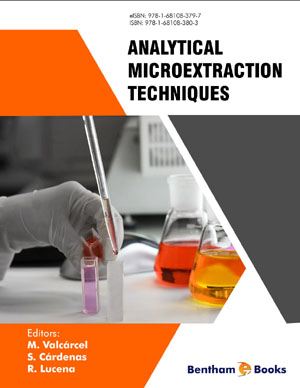Abstract
The usefulness of dispersive extraction techniques leans on their ability to maximize the interaction between the sample and the extractant phase, thus increasing the extraction efficiency. As far as dispersive solid phase extraction is concerned, it was initially developed to increase the selectivity of the analytical process because the solid was added to retain the potential interferents from the sample matrix. In spite of its efficient sample clean-up, the sensitivity is its Achilles' heel as no preconcentration is usually achieved. Recently, the use of few milligrams of sorbent which is dispersed in a liquid sample for analytes isolation has raised a new miniaturized extraction technique, the so-called dispersive micro solid-phase extraction. This alternative is mainly focused on sensitivity enhancement. The chapter begins with a short contextualization of this extraction technique, followed by a brief description of the first approach in this context, viz, dispersive solid phase extraction. Next, the main contributions in the field of dispersive micro solid-phase extraction in this context will be described on the basis of the nature of the solid used. Also, the combination with dispersive liquid phase microextraction and the expected evolution of this miniaturized extraction technique are included.
Keywords: Auxiliary energies, Carbonaceous solids, Conventional sorbents, Dispersive extraction, Dispersive liquid-liquid microextraction, Dispersive solid phase microextraction, Dispersive sorbent, Enrichment factors, Green chemistry, Miniaturization, Molecularly imprinted polymers, Nanostructured sorbents, Polymeric sorbents, Silica-based sorbents, Solid phase microextraction.






















